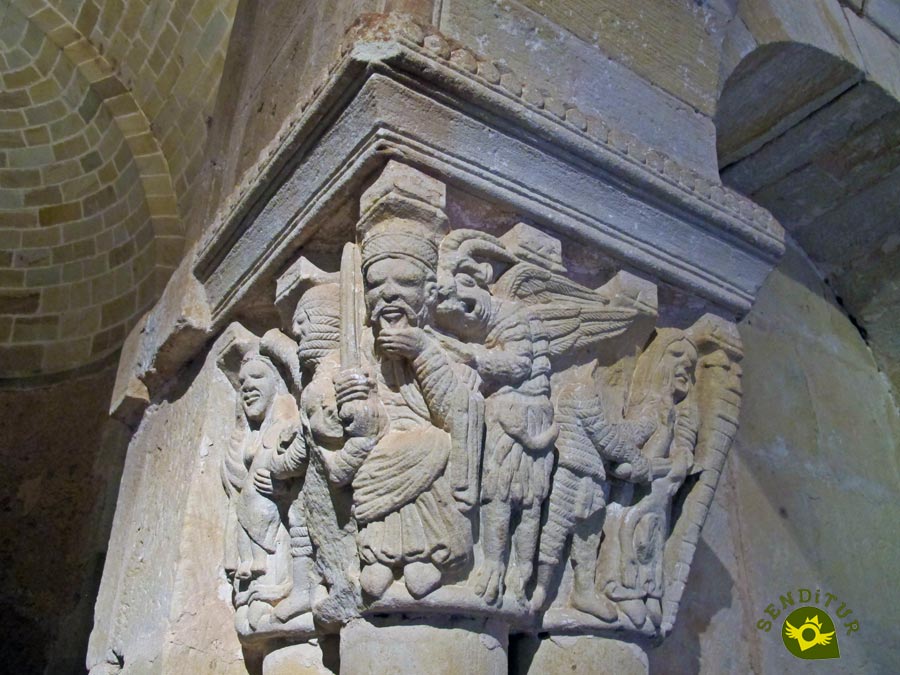As the Monastery of San Juan de Duero is known, it is located on the outskirts of Soria, on the banks of the Duero and protected by the El Mirón Hill and the Mount of Animas. In this beautiful enclave the Hospitallers of San Juan de Jerusalem, taking advantage of the repopulation action of Alfonso I, decided to settle down to carry out their work of protection and shelter of walkers, pilgrims and the helpless, and taking advantage of the simple church that was here they reformed it and built a monastery that also had a hospital. This monastery, built between the 12th and 13th centuries and dedicated to San Juan Bautista, patron saint of the order of San Juan knights, remained inhabited until the 18th century. After years of abandonment it was declared a National Monument in 1882 and years later it was annexed to the medieval department of the Numantine Museum.

Of the primitive monastic complex, only the church and the cloister of the monastery remain, which, adjacent to it, is an impressive example of medieval Christian architecture, being considered one of the Wonders of Spanish Romanesque, is located south of the church and has an irregular quadrilateral shape with chamfered corners. It served to communicate the different areas of the monastery and there were burials there between the 13th and 15th centuries. Its arcade is a true symphony of architecture and styles, with four well-differentiated sections that do not break the harmony and that go from pure Romanesque, with double columns, to slightly pointed horseshoe arches, Almoravids and Nazarites, others that intertwine... The church, today without worship, is very simple, and the small temples on both sides of the presbytery are striking. Their construction, after that of the church, is believed to be motivated by the primitive Christian rite with Greek influences in which the priest hid, at the moment of consecration, behind a large cloth that these would hold as an iconostasis. Each one of them houses an altar and each one has a different dome, semi-spherical one and the other conical one.

It was a tradition that the Jurors, a couple for each neighborhood or quadrille that becomes a solemn ceremony and with delivery of canes of command in " Mayors of Neighborhood ", used the monastic set, already abandoned, for his annual celebration of the holidays of San Juan.
In the competition held by the Centre for Romanesque Studies (CER) to find out which were the seven most admired Romanesque buildings, San Juan de Duero came in fourth place, after San Isidoro de León, the Cathedral of Santiago de Compostela and the Old Cathedral of Salamanca.

Legend has it that at the time of the Arab invasion a group of Christians were taken prisoner and locked in a cilla or barn and that they drew on the wall an image of the crucified Christ. That night they all dreamt the same thing, that Christ appeared to them and urged them to be patient because in the end they would be freed. When they woke up they told each other the dream they thought it was a fatal illusion and that one thing was to preach and the other was to give wheat. When the Christians were released, the place was used as a barn, but it was not surprising that no matter how many sacks of grain were taken out, the barn was always full. One day they decided to go down to the bottom of the silo and then they discovered an image of a crucified Christ identical to the one drawn on the wall and how their astonishment would increase when they heard him say How forgotten you have me, although besides preaching I give you wheat! The carving was then moved to San Polo but, perhaps and before its current location, who knows? this Christ of Oblivion or Christ Cillero could also have been on the altar of San Juan de Duero.
MORE ROUTES AVAILABLE, DON'T MISS IT...
MORE PLACES AVAILABLE, DON'T MISS IT...
The N-111 passes through Soria, which connects it with Logroño on the one hand, and on the other, which has now become the A-15, linking it with Medinaceli and the A-2. The national roads N-234 and N-122 also cross Soria and communicate it with Burgos and Calatayud, the first one, and with Valladolid, Aranda del Duero and Tarazona the second one. The Soria bus station, located at 40, Valladolid Avenue, is served by regular public transport buses from the main cities and capitals. Soria has a train station, El Cañuelo, whose service covers the Torralba-Soria line and connects the city of Soria with the Madrid-Barcelona line.
We leave Soria city through San Agustín street, we will pass by the Concathedral and after crossing the Duero Bridge, on our left we will find the short walk that leads to the doors of Arches of San Juan de Duero. If we move by car we will have to advance a few meters until we find the road to Almajano where we will turn left, as we arrive from Soria city, to start looking for parking in one of the areas prepared for this purpose and from there approach to the monastery.
SENDITUR is not responsible for any variation in the information described, as well as for the misuse of its guides and recommends that everyone be responsible and prudent in carrying out the activity. Likewise, we invite you to document yourself with books and specialized guides to complement the information described. From the commitment of SENDITUR with Nature and the respect to the balance of the environment, SENDITUR urges you to travel in a responsible way, with low environmental impact and respecting at all times the Natural, Cultural and Social environment wherever you go. For any suggestion, SENDITUR invites you to send an email to
Continue watching …